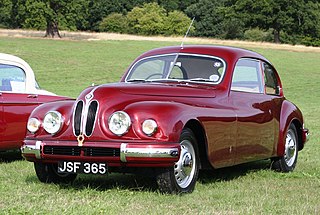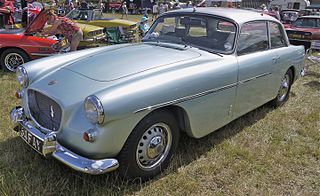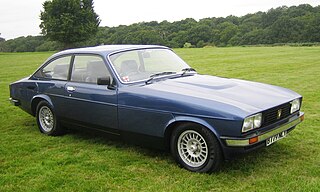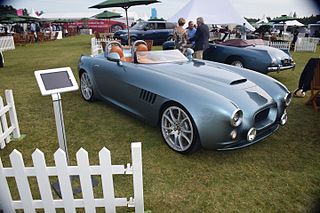 W
WThe Bristol 400 is a luxury car produced by the Bristol Aeroplane Company of Great Britain, its first. After World War II, BAC decided to diversify and formed a car division, which would later be the Bristol Cars company in its own right. BAC subsequently acquired a licence from Frazer Nash to build BMW models.
 W
WThe Bristol 401 saloon and Bristol 402 cabriolet are British luxury sporting cars, produced between 1948 and 1953 by Bristol Cars, an offshoot of the Bristol Aeroplane Co.. They were developed from the Bristol 400, which continued in production alongside the 401 and 402 until 1950.
 W
WThe Bristol 401 saloon and Bristol 402 cabriolet are British luxury sporting cars, produced between 1948 and 1953 by Bristol Cars, an offshoot of the Bristol Aeroplane Co.. They were developed from the Bristol 400, which continued in production alongside the 401 and 402 until 1950.
 W
WThe Bristol 403 is a luxury car which was produced from 1953 to 1955 by British manufacturer Bristol Aeroplane Co.. The 403 was the third of the eventual five series of Bristols powered by the BMW-derived pushrod straight-six engine. It replaced the Bristol 401 and 402 in 1953 and continued in production for two years.
 W
WThe Bristol 404 and Bristol 405 are British luxury cars which were manufactured by the Bristol Aeroplane Company. The 404 was manufactured from 1953 to 1958, and the 405 from 1955 to 1958. The models were successors to the Bristol 403. The 404 was a two-seat coupé and the 405 was available as a four-seat, four-door saloon and as a four-seat, two-door drophead coupé.
 W
WThe Bristol 404 and Bristol 405 are British luxury cars which were manufactured by the Bristol Aeroplane Company. The 404 was manufactured from 1953 to 1958, and the 405 from 1955 to 1958. The models were successors to the Bristol 403. The 404 was a two-seat coupé and the 405 was available as a four-seat, four-door saloon and as a four-seat, two-door drophead coupé.
 W
WThe Bristol 406 was a luxury car produced between 1958 and 1961 by British manufacturer Bristol Aeroplane Co. Their cars were constructed to very high engineering standards and were intended to be long-lasting to justify their very high price. Buyers might arrange considerable changes to the specification of their own particular vehicle. Bristol Aeroplane's car division later became Bristol Cars.
 W
WThe Bristol 407 was a sports tourer car produced by British manufacturer Bristol Cars between 1961 and 1963. It was the first Bristol model to be made by the company after separation from the Bristol Aeroplane Company, which had built all previous Bristol models. Outwardly it resembled the 406, on which it was based, and which had been produced between 1958 and 1961.
 W
WThe Bristol 408 is a British luxury car made by Bristol Cars between 1963 and 1966. Unusually for Bristol, a slightly revised version was launched during the middle of the model's production run in 1965 and known as the 408 Mark II.
 W
WThe Bristol 409 was the third series of cars from British manufacturer Bristol Cars powered by Chrysler V8 engines. It was actually introduced before the older Bristol 408 went out of production and only gradually supplanted that model after a year.
 W
WThe Bristol 410 was the fourth series of Chrysler V8-engined models from British manufacturer Bristol Cars. It was the last Bristol to use the 5.2-litre (318 cubic-inch) engine originally found in the Bristol 407.
 W
WThe Bristol 411 is an automobile which was built by the British manufacturer Bristol Cars from 1969 to 1976. It was the fifth series of Chrysler-V8 engined Bristol models. The car was rated highly for its comfort, performance and handling by contemporary reviewers.
 W
WThe Bristol 412 is a car which was produced by British manufacturer Bristol Cars from 1975 to 1986. Variants were produced as the Bristol Beaufighter, from 1980 to 1993, and as the Bristol Beaufort, from 1984 to 1994.
 W
WThe Bristol Type 603 is a car which was launched in 1976 by British manufacturer Bristol Cars to replace the 411. With the 603 – introduced along with the Zagato-built 412 – the Bristol car underwent its first major facelift since the introduction of the 406 in the late 1950s. The design was to last until the marque's (temporary?) demise in 2011. Bristol's chief designer Dudley Hobbs strived to make the car more spacious and aerodynamic, while also using flatter body panels that would be easier to hammer.
 W
WThe Bristol 412 is a car which was produced by British manufacturer Bristol Cars from 1975 to 1986. Variants were produced as the Bristol Beaufighter, from 1980 to 1993, and as the Bristol Beaufort, from 1984 to 1994.
 W
WThe Bristol 412 is a car which was produced by British manufacturer Bristol Cars from 1975 to 1986. Variants were produced as the Bristol Beaufighter, from 1980 to 1993, and as the Bristol Beaufort, from 1984 to 1994.
 W
WThe Bristol Type 603 is a car which was launched in 1976 by British manufacturer Bristol Cars to replace the 411. With the 603 – introduced along with the Zagato-built 412 – the Bristol car underwent its first major facelift since the introduction of the 406 in the late 1950s. The design was to last until the marque's (temporary?) demise in 2011. Bristol's chief designer Dudley Hobbs strived to make the car more spacious and aerodynamic, while also using flatter body panels that would be easier to hammer.
 W
WThe Bristol 400 is a luxury car produced by the Bristol Aeroplane Company of Great Britain, its first. After World War II, BAC decided to diversify and formed a car division, which would later be the Bristol Cars company in its own right. BAC subsequently acquired a licence from Frazer Nash to build BMW models.
 W
WThe Bristol Type 603 is a car which was launched in 1976 by British manufacturer Bristol Cars to replace the 411. With the 603 – introduced along with the Zagato-built 412 – the Bristol car underwent its first major facelift since the introduction of the 406 in the late 1950s. The design was to last until the marque's (temporary?) demise in 2011. Bristol's chief designer Dudley Hobbs strived to make the car more spacious and aerodynamic, while also using flatter body panels that would be easier to hammer.
 W
WThe Bristol Bullet is a two-seat, open-top sports car produced by Bristol Cars. Originally announced under the working title of "Project Pinnacle" in 2015, it was first shown to the public under camouflage at the 2016 Goodwood Festival of Speed. The Bullet commemorates Bristol's 70th anniversary, and is the company's first all-new car since the Bristol Fighter, which was produced between 2004 and 2011, as well as the first Bristol car to utilize a carbon fibre body and a Morgan Plus 8 chassis. Power is sourced from a naturally aspirated 4.8-litre BMW V8 producing 400 bhp, but will be the last Bristol to do so before switching to forced induction engines. The retro design was a homage of the Bristol 405 Drophead coupé.
 W
WThe Bristol Fighter is a sports car produced by Bristol Cars in small numbers from 2004 until the company suspended manufacturing in 2011. It is generally classed as a supercar.